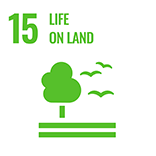Managing forests for climate resilience in Nepal

Summary
Climate change and development activities can be very difficult to reign in, but we can better plan and manage forest ecosystems to strengthen their protection. In Nepal, there is a lack of accurate information on forest degradation and climate change impacts on forest ecosystems – information that is crucial in assisting decision-makers plan and manage forests. The Climate Resilient Forest Management System developed by our SERVIR/HKH Initiative and partners aims to fill this gap and enhance decision-making at the district level in Nepal by providing more precise and scientific information on climate change vulnerability and degradation of forest ecosystems.
In the last few decades, the Hindu Kush Himalaya (HKH) region has undergone rapid economic and social changes. Unplanned and haphazard development activities have had severe impacts on forests in the region. Furthermore, increasing temperature, drought, changes in phenology, increasing pest and fire outbreaks, and changing nutrient dynamics due to climate change have altered the composition, productivity, and biogeography of forests. Forest ecosystems are now experiencing even higher levels of degradation because of climate change. The region has also experienced vegetation shifts and a decline in vegetation productivity.
Nepal’s forests have been one of the most vulnerable to climate change in the region. Around 40% of Nepal’s geographical area is covered by forests, with a high dependency on these forests for everyday needs and livelihoods. An estimated 80% of the population depend on forests for fuel wood, timber, and grazing. Given the dependency on forests, the threat to forests and ecosystems is a huge threat to the communities who depend on them, calling for urgent adaptation planning and implementation. Nepal’s forest statistics reveal that forest degradation has become more critical than deforestation.
Understanding climate change adaptation and forest management plays a vital role in combating climate change and mitigating its effects. In the Hindu Kush Himalaya (HKH) region, forests are a source of livelihood for the region’s growing population. With forest degradation and deforestation increasing, it has become all the more necessary to have a reliable climate resilient forest management system. At present, precise information on forest degradation and the impacts of climate change on forest ecosystems is unavailable in the HKH. The kind of detailed information required for district level planning is missing. A comprehensive climate policy requires ground-based information about vulnerable systems and the stressors they are exposed to, as well as the transfer of resources to vulnerable societies in order to help them to prepare to cope with the inevitable impacts of climate change.
Overview
- Location:
- Implementation sites:
-
- Single country
- Multiple locations
- Mountain region:
-
Hindu Kush Himalaya
- Solution scale:
- Ecosystem type(s):
- Solution type(s):
- Sector(s):
- Climate impact(s) addressed:
- Climate impact time-scale(s):
- Co-benefit(s) associated with the solution implementation:
- Implementation timeline:
-
- 2023 - 2023
- Sendai targets:
-
Solution details
Main beneficiaries & outcomes
The Climate Resilient Forest Management System, with its open-access information and a suite of adaptation options, will benefit forest users and managers across Nepal in decision-making processes. The decision-support tool also comprises of a module on forest management at the community forest level, which can support decision-makers at community forest user’s groups (CFUGs) to understand the trends and predicted scenarios of climate sensitivity, degradation, and forest-fire risk. It can also show them the current patterns of gender and social inclusion in the decision-making processes in the CFUGs. All such tools should further strengthen the capability of CFUGs in the planning and management of forest ecosystems.
Planning and implementation
Climate Resilient Forest Management System is one of the services under SERVIR-HKH that is being implemented in Nepal in collaboration with Department of Forests & Soil Conservation (DoFSC) and Ministry of Forest & Environment (MoFE), Government of Nepal. The partners of this program also include Hariyo Ban II program that comprises of World Wildlife Fund (WWF) Nepal, CARE Nepal, FECOFUN, and NTNC. The CRFMS framework follows a “Science into Use” approach that can play an important role in enhancing the forest management. It aims to reduce the vulnerability of forests to climate change and the degradation of forest ecosystems due to anthropogenic drivers.
As part of the system, a web-based decision support tool was developed that provides information on present and future climate sensitivity, forest degradation, forest fire risk and forest vulnerability. Using geospatial tools and techniques, and a multi-tier approach to vulnerability assessment and adaptation planning, the support tool effectively identifies “adaptation footprints” – areas requiring urgent adaptation intervention and forest management because of high sensitivity to climate change and high levels of degradation of forest ecosystems. An adaptation planning toolbox provides a list of suitable adaptation options that can be implemented to enhance resilience of the forest ecosystems. Other outputs include observed climate sensitivity of forests from 2000-2020, predicted climate impacts under RCP 4.5 for the year 2050, forest degradation, and forest fragmentation.
The tool has been a key instrument for decision-makers in Nepal to analyze the vulnerability profile of forest ecosystems at the district/division level, providing user-friendly access to information on climate sensitivity, degradation, and forest fire risk for all 77 districts in Nepal. The profile acts as a guiding document to identify the degradation and vulnerability hotspots which assists in decisions and priorities of forest management for a particular district and also includes options to compare any two parameters side-by-side for the same study area. Furthermore, it includes community forest management as a component, where the role of gender and social inclusion in management practices in 225 community forest user groups in Nepal is analyzed. The information covering community forests adds a layer of previously unavailable information, which together with updated scientific evidence provides inputs for crucial community-level forest management plans.
Finance
N/A
Innovation
N/A
Long term project sustainability and maintenance
Every five years, Nepal’s divisional forest offices prepare and revise forest management and operational plans, which also have a section on climate change adaptation. The findings from a study on the Climate Resilient Forest Management System will be included in this section wherein it will describe the current and predicted climate-sensitivity indices and the observed trends in forest degradation, along with the some six suitable adaptation measures that can be adopted. The framework of the International Union of Forest Research Organizations (IUFRO) on climate change adaptation suggests a list of 144 adaptation options for forest ecosystems across the world. Out of that, the study’s authors, using this tool, have shortlisted six adaptation options through consultations held in the three study districts; these could be suitable for building the resilience of forest ecosystems not only in these districts, but also for Nepal as a whole. The six options are: forest-fire regulation; grazing regulation; improving stock levels; introducing/enhancing agroforestry; utilizing solar energy; and maintaining forest cover.
Capacities for design and implementation
Knowledge
Scientific evidence and information has played a key role in the implementation of the solution. This alongside the geospatial data is informing decision-making plans at different spatial scales across Nepal on climate change assessments, forest degradation, and potential adaptation options.
Technology
The solution relies on satellite datasets (Landsat 8, MODIS, SRTM) to produce visual maps of data and assess vulnerability by quantifying changes in albedo, land surface temperature, leaf area index, and primary productivity.
Socio-cultural
To ensure accurate incorporation of user needs, the service was co-designed through a series of user consultations and engagements at different levels. The service-planning process broadly involved three steps: needs assessment, service design, and service delivery. The needs assessment conducted with different stakeholders highlighted that there were gaps in district-/divisional-level forest management, which could be addressed by adding scientific evidence and more useful information on climate change impacts.
Outlook & Scalability
Potential for upscaling and replication
The aim is to scale out this framework to the whole of the HKH region, but without restricting it to this region alone—this framework can be easily implemented in any part of the world. With the advent of freely available satellite data and platforms like GEE, the CRFMS can be applied to reduce both time and resources. Ultimately and looking into the future, it is the geospatial tools that are going to be the prime players in decision making, not only in the HKH but also globally.
- Climate-resilient forest management in Nepal
- Inter-regional Project for Participatory Upland Conservation and Development (PUCD)
- Taming Wildfires: Addressing climate change impact through enhanced capacity for wildfires management in Armenia
- Seizing local opportunities in Armenia
- Management and conservation of wetlands and paramos in Venezuela
- Landscape Approach to Forest Restoration and Conservation in Rwanda



Comments
There is no content